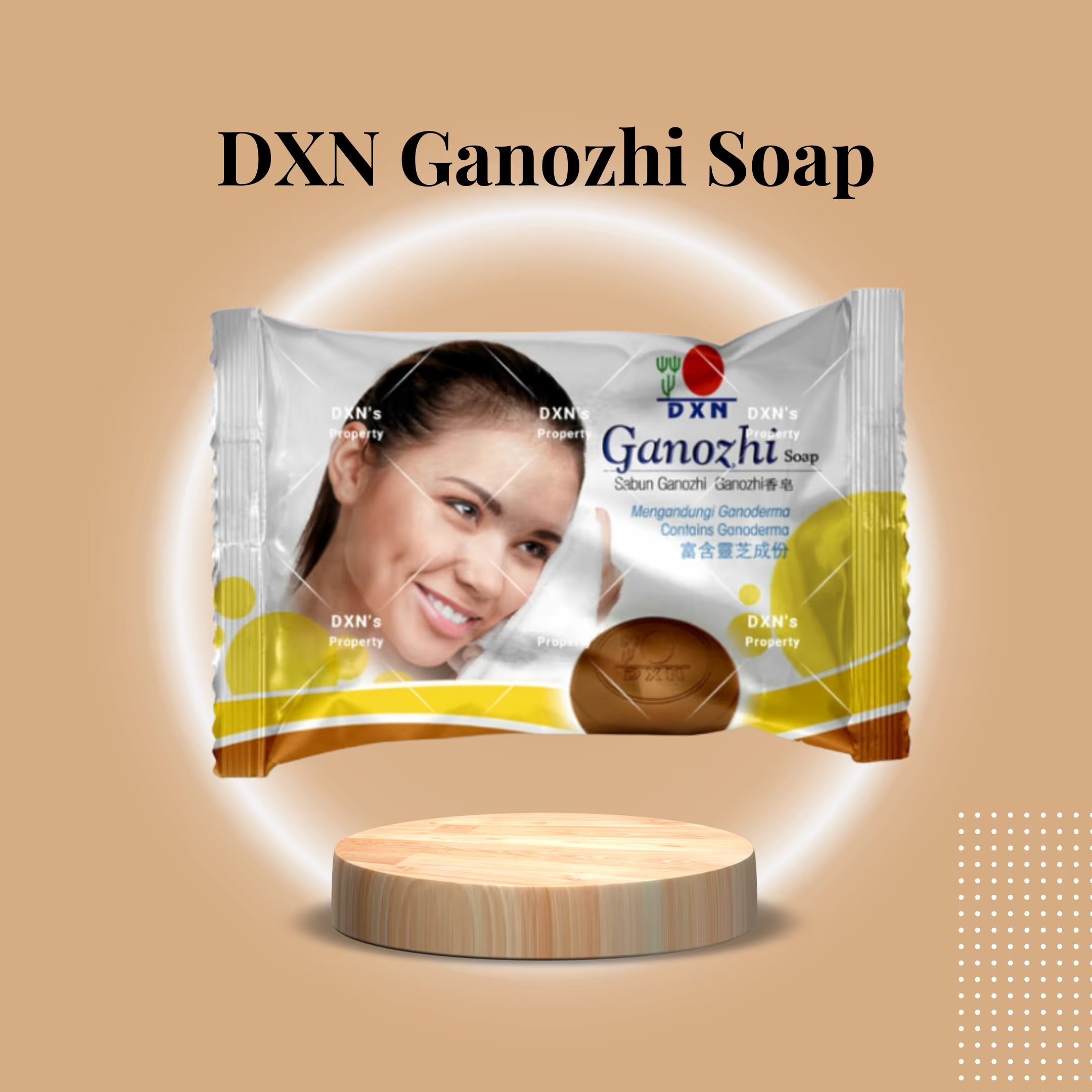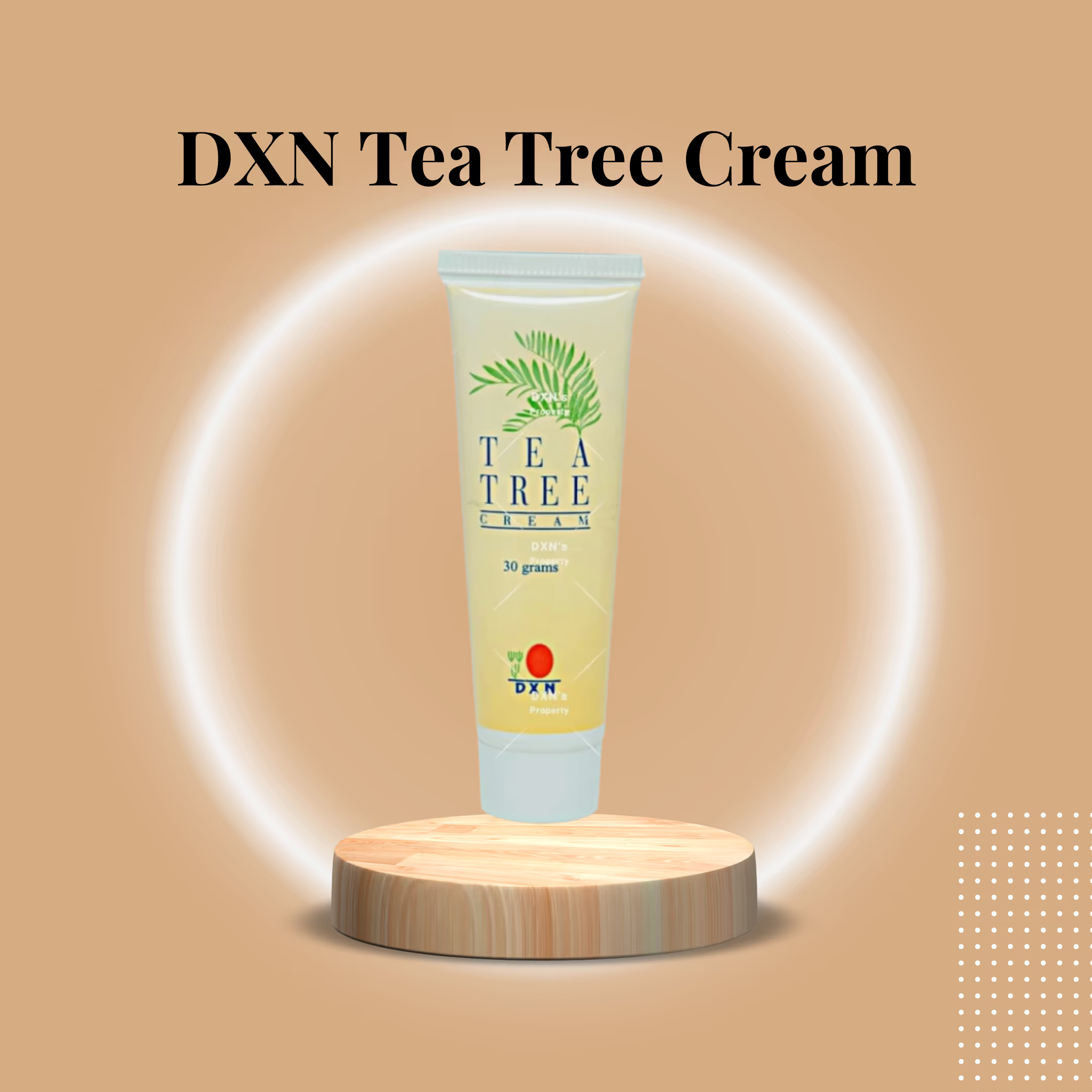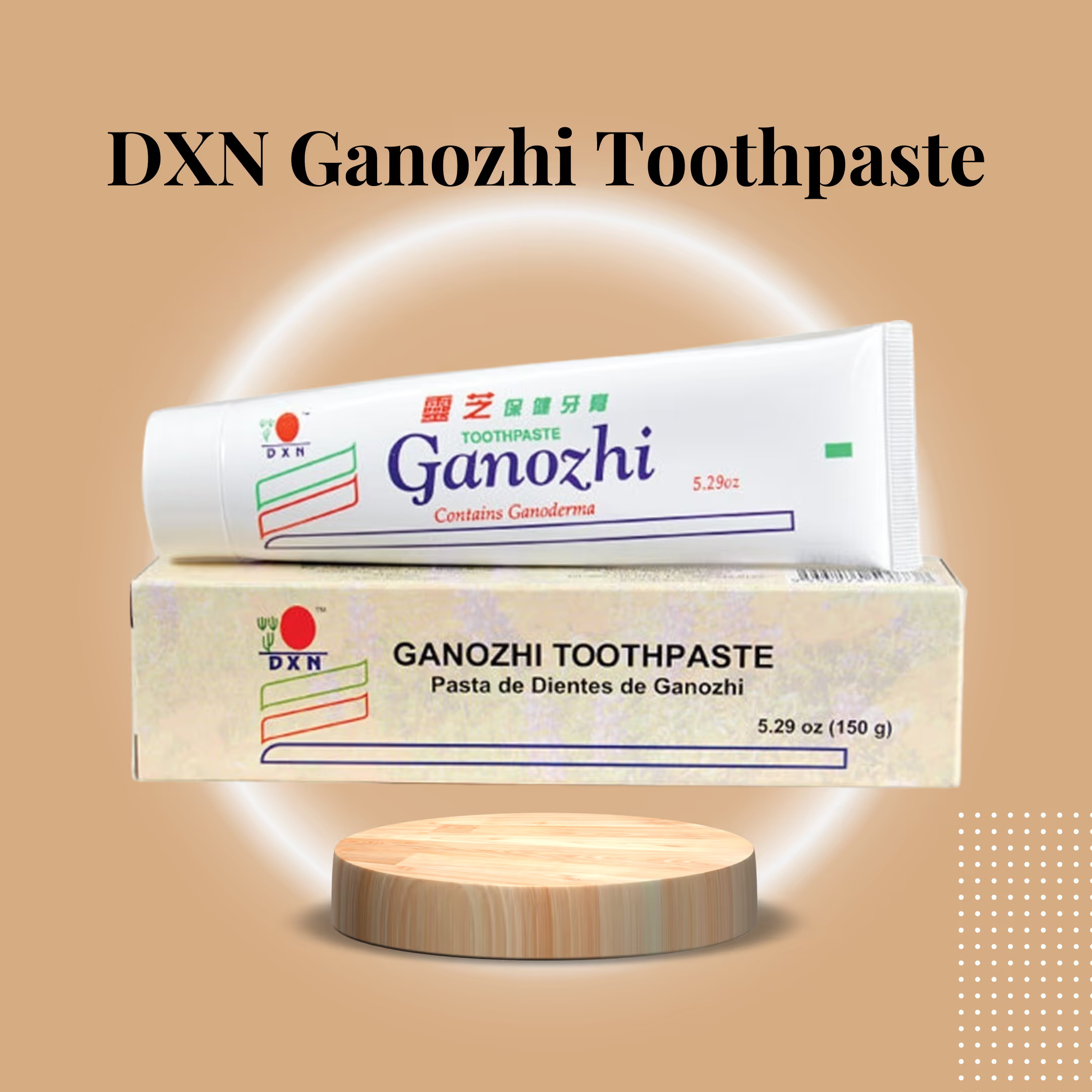What makes a cleanser “therapeutic”?
At the simplest level, a cleanser should remove grime, sebum, and surface pollutants. But effective long-term skin care demands more: a cleanser should preserve barrier integrity, maintain optimal pH, and ideally deliver functional ingredients that actively support skin health. A therapeutic cleanser, therefore, does four things well at once:
- Cleans gently but thoroughly — removes impurities without over-stripping lipids.
- Maintains or restores physiological pH — keeps the acid mantle intact.
- Hydrates during cleansing — offsets drying that commonly follows soap use.
- Delivers bioactive support — antioxidants, anti-inflammatories, or other actives that help repair and strengthen skin.
DXN Ganozhi Soap is formulated with the following objectives in mind: a balanced surfactant system, a humectant-rich base, and Ganoderma extract, all of which are buffered to prevent alkaline shock to the skin.
The product concept: cleansing that cares
DXN positions the Ganozhi Soap not as a cosmetic touch-up but as a foundational, daily therapeutic product. Its formulation strategy revolves around three pillars:
- Mycotherapy — using Ganoderma lucidum (Reishi) to bring antioxidant, anti-inflammatory, and anti-melanogenic properties to the skin.
- pH science — fine-tuning the bar so it respects the skin’s slightly acidic environment (typically pH 4.5–6.5).
- Moisture protection — incorporating humectants (glycerin) and emollient-rich palm-derived saponified materials to prevent transepidermal water loss (TEWL).
This combination reframes the soap from a passive cleaning tool into an active step in a therapeutic regimen—one that stabilizes the skin, allowing subsequent serums and moisturizers to perform optimally.
Key ingredients decoded
Below are the primary functional components and their significance.
Ganoderma lucidum extract (Reishi)
Reishi is the defining star of the soap. Extensive ethnobotanical use and modern analyses highlight two classes of molecules that matter topically:
- Triterpenoids — these molecules have demonstrated anti-inflammatory and antioxidant activity and can influence melanogenesis (the process of pigment production). Triterpenoids can help calm redness and modulate pathways involved in pigment formation.
- Polysaccharides — potent humectants and immune modulators; at the skin surface, these molecules help bind water, support barrier integrity, and encourage a healthier, more resilient epidermis.
Together, these constituents provide a multifaceted effect, shielding the skin from oxidative damage, reducing inflammation, and contributing to a brighter, more even tone.
Glycerin
A universally trusted humectant, glycerin attracts moisture from the environment and the deeper epidermal layers to the outer skin, helping maintain hydration while the soap cleanses. Its inclusion counteracts the drying effects of many saponified bars.
Sodium palmate / palm oil-derived soap base
Derived from palm oil saponification, the base provides stable lather and conditioning lipids. Properly formulated, it can yield a smooth, emollient foam that cleans without excessive alkalinity. Palm-based soap bases also naturally contain tocopherols (forms of Vitamin E), which contribute antioxidant value.
pH balancer and scent components
A pH-balancing system maintains the finished bar at a skin-friendly acidity, thereby preserving the acid mantle. Trace aroma compounds (controlled fragrance notes and safe aromatic constituents) provide a pleasant sensory experience while being selected and dosed to minimize irritation risk.
The science of pH and the acid mantle — why it matters
The skin’s surface is not neutral; it is slightly acidic. This acid mantle serves as:
- a microbial control mechanism that discourages pathogenic overgrowth,
- an enabler of lipid-processing enzymes that construct and repair the barrier, and
- a key factor in preserving stratum corneum cohesion and desquamation.
When you cleanse with strongly alkaline products (many traditional bar soaps), the skin’s pH is lifted toward neutrality or alkalinity. That shift temporarily disables key enzymes involved in barrier maintenance, increasing TEWL and leaving the skin tight, flaky, or prone to irritation and infection.
DXN Ganozhi Soap is formulated to avoid that outcome. The pH-balancing ingredients are there to keep the skin within its physiological range. The impact is immediate comfort post-wash and long-term protection against chronic barrier disruption.
Antioxidant defense and anti-aging rationale
Daily exposure to UV radiation, pollution, and metabolic stress generates free radicals that drive premature aging, characterized by collagen breakdown, elastin damage, and the development of fine lines. Antioxidants stabilize these reactive species and reduce cumulative damage.
Reishi’s triterpenoids and other phenolic-like components act as antioxidants. When regularly applied to the skin surface, they contribute to a protective layer that reduces oxidative stress. Over time, a consistent reduction in oxidative stress can translate into slower wrinkle progression, a preserved skin tone, and a healthier overall texture.
Brightening and pigment control: how Ganoderma helps even tone
Hyperpigmentation stems from localized overproduction or uneven distribution of melanin. The enzyme tyrosinase is central to that biology. Scientific observations indicate Reishi-derived triterpenes can inhibit tyrosinase activity, thereby moderating melanin synthesis over time.
Used as part of a daily cleanse, Ganozhi Soap provides repeated exposure to these anti-melanogenic constituents. Rather than a single powerful depigmenting blitz (which can be irritating), it favors steady, gentle modulation—reducing future spot formation while supporting a more luminous, even complexion.
Anti-inflammatory action and calming benefits
A large portion of skin complaints—such as redness, itch, and reactive flare-ups—are driven by low-grade inflammation. Reducing that inflammatory tone helps the skin appear calmer, reduces the incidence of visible irritation, and supports barrier recovery.
Ganoderma acts on inflammatory pathways via its triterpenes and polysaccharides. By incorporating Reishi into a daily wash, the soap helps shift the scalp and skin environment toward lower reactivity. For people with sensitive skin types, this can materially reduce the frequency and severity of flare-ups.
How the soap serves different skin types
Dry / mature skin
Concerns: dehydration, impaired barrier, fine lines.Why Ganozhi helps: glycerin and a conditioning saponified base provide moisture during cleansing; Reishi assists in tissue repair and antioxidant defense to slow age-related decline.
Oily / combination skin
Concerns: excess sebum, recurrent breakouts, compromised pH, and promoting microbial imbalances.Why Ganozhi helps: gently removes sebum without over-stripping; maintains acidic pH to control pathogenic microbes and reduce the cycle of over-cleansing and rebound oil production.
Sensitive / reactive skin
Concerns: redness, stinging, susceptibility to irritants.Why Ganozhi helps: pH-balanced formula protects the acid mantle; Reishi’s anti-inflammatory compounds soothe and reduce reactivity; glycerin prevents post-wash tightness.
Acne-prone skin (nuanced)
Concerns: inflamed lesions, bacterial proliferation, excess sebum.Why Ganozhi helps: by stabilizing pH and reducing inflammation, the soap creates conditions less favorable to microbial overgrowth. However, it is not a medical acne treatment—severe cases may still require targeted actives (benzoyl peroxide, retinoids, topical antimicrobials).
How to use DXN Ganozhi Soap for the best results
Extracting maximal benefit requires consistency and a little ritual:
- Frequency: Twice daily is suitable for most facial use; body use can be adjusted according to personal preference. For very dry skin, once daily may suffice.
- Lather method: Create a rich foam in your hands (or use a soft washcloth or konjac sponge). Gently apply in circular motions; avoid aggressive rubbing.
- Contact time: Allow the foam to sit briefly on areas of concern (10–30 seconds) to allow the Ganoderma compounds to have contact time, then rinse thoroughly with lukewarm water.
- Follow-up: Apply a toner or serum appropriate for your skin (toner to rebalance, serum for active treatment) and seal with a moisturizer. The soap’s pH moderation primes the skin to better absorb subsequent actives.
- Special mask use: For stubborn pigmentation or persistent dullness, apply the lather once or twice weekly and allow it to remain for a few minutes, similar to a rinse-off mask—this extends exposure to active botanicals without the irritation associated with stronger actives.
Integrating the soap into a full DXN regimen
DXN’s ecosystem approach is meaningful. Use patterns that combine cleansing with toning and deeper treatments:
- Step 1: Ganozhi Soap — gentle cleansing, pH-friendly.
- Step 2: Ganozhi Toner — pore refinement, additional Ganoderma support, allantoin, and propolis for repair.
- Step 3: Ganozhi Moisturising Micro Emulsion (or a chosen moisturizer) — deep hydration with nano-delivered actives like Ganoderma, ginseng, and Vitamin E.
This sequence preserves the barrier and increases the effectiveness of active ingredients that rely on an intact acid mantle for optimal penetration and activity.
Comparing Ganozhi Soap to other cleansing options
- Versus alkaline soap bars: Ganozhi avoids the pH spike and severe lipid stripping associated with many traditional soaps. The result is less tightness, less flaking, and a healthier long-term barrier.
- Versus foam cleansers/sulfate-based gels: Many gel cleansers utilize stronger surfactants for deep cleansing. Ganozhi balances cleansing efficacy with conditioning lipids and humectants to prevent over-drying.
- Versus micellar waters/oil cleansers: These alternatives are effective at removing makeup but are not typically designed to deliver active botanicals and may require a follow-up cleanse. Ganozhi merges cleansing with therapeutic botanical delivery.
Safety, tolerability, and special considerations
- Fragrance & allergen sensitivity: The product contains a stable, controlled aroma system. Individuals with fragrance allergies should patch-test.
- Infants and delicate skin: The gentle pH and humectant profile make it suitable for older children; for infants, consult a pediatrician before routine use.
- Medical conditions: Individuals with active dermatological disease (severe eczema, infected lesions) should consult a clinician before changing their regimen.
- Pregnancy and breastfeeding: Topical Reishi has low systemic absorption when used as a rinse-off product; however, consult a healthcare professional if concerned.
Sustainability & sourcing notes (practical perspective)
Palm oil sourcing raises ethical questions in general; responsible brands seek certified sustainable palm oil and transparent supply chains. When selecting botanical and oil-based products, look for declarations regarding sustainable sourcing and third-party certifications that indicate a reduced environmental impact. DXN’s narrative around quality and natural sourcing suggests attention to ingredient integrity, but conscientious shoppers should verify sourcing claims when sustainability is a priority.
Realistic expectations and timelines
- Immediate effects (first use): smoother skin feel, less post-wash tightness, softer texture thanks to glycerin and conditioning lipids.
- Short-term (2–6 weeks): reduced transient redness and improved hydration; early signs of brighter skin tone with consistent use.
- Long-term (3 months+): cumulative antioxidant protection and anti-inflammatory action contributing to improved texture, reduced pigment contrast, and slowed age-related degradation.
Consistency matters. The soap is a foundational product; many visible benefits accumulate through regular, correct use rather than dramatic overnight miracles.
.avif)





